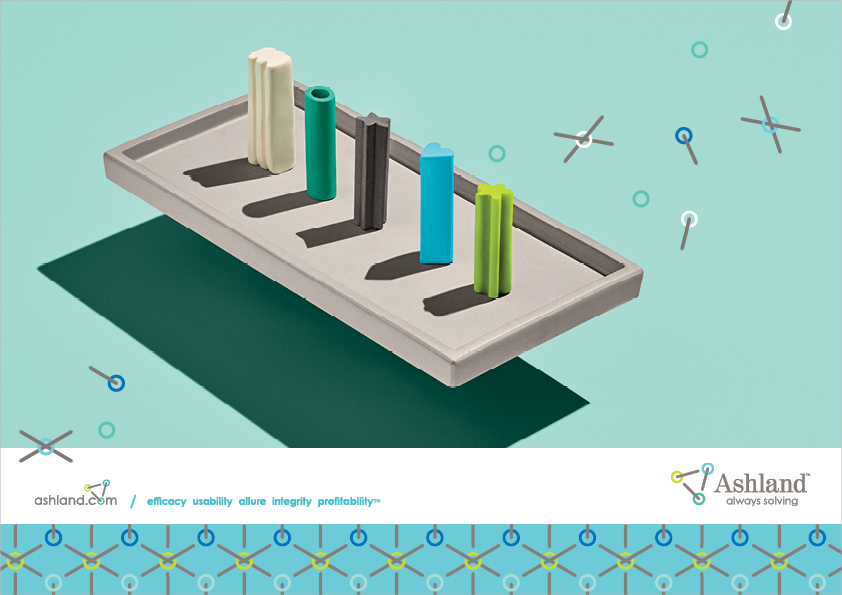advanced and traditional ceramics
who gets fired up at the thought of solving a problem? we do.
From glazes that don't drip to stronger greenware to the advanced ceramics used in catalytic converters, and environmental filters, Ashland's knowledge in traditional and advanced ceramics can help you reduce waste and increase profits. Ashland products strengthen greenware making it less prone to breakage both before and during the firing process. And, our rheology products help create glazes that don't run or drip keeping your ceramic designs beautiful.
advanced ceramics
Manufacturers of advanced ceramics such as catalytic converters, gasoline & diesel particulate filters and industrial environmental filters require ingredients that provide the right amount of plasticity and workability during the shaping and molding process, while maintaining firmness of the wet mass after extrusion and before/during drying (wet green strength). Other advanced ceramics like catalyst carriers made into different shapes and using various shaping techniques (extrusion, dry pressing, isostatic pressing, etc.) also require organic binders to provide strength and cohesion of the shaped ceramic product.
During the drying process, these ingredients help ensure uniform, controlled drying and prevent the formation of cracks and blisters that can affect the performance of the converter, filter and other shapes. Although the needs are the same, different binders are used for the different manufacturing processes depending on raw materials, equipment as well as end product requirements. All manufacturers want to minimize costly equipment maintenance and repairs so they are also looking for products that help reduce wear and tear on manufacturing equipment and completely burn so there is little to no residue to deal with after manufacturing. Ashland offers a variety of products that can help solve these manufacturing needs.
traditional ceramics
To create beautiful ceramics, artists are looking for binder ingredients that increase the plasticity or workability of the material while providing enough strength to maintain the shape during the drying stage. Ashland products are also used as rheology modifiers to allow the glaze to go on easily without dripping or running. These products also produce a strong, tight bond between the glaze and the ceramic body to prevent both damage to the surface prior to firing, and cracking during or after firing, which are especially important for both food and beverage applications.
products
Ashland offers a large variety of chemically different cellulose ethers, which differ in chemistry allowing them to be used in different media / solvent systems depending on the shaping or application process. Some products develop their full potential when dissolved in organic solvents, other dissolve in water and polar solvents and others are purely water soluble.
read more >

aqualon™ and blanose™ carboxymethylcellulose (CMC)
Carboxymethyl cellulose products are e.g. widely used in ceramic glazes. Here, specifically low molecular weight products are being used to prevent or reduce sedimentation, have a low impact on the glaze viscosity and support adhesion of the glaze on the ceramic substrate. Low molecular weight carboxymethyl cellulose is also widely used for die pressing applications, where it is incorporated as a binder during the spray drying process of the cera...
natrosol™ hydroxyethylcellulose
Hydroxyethyl cellulose products find use in various ceramic shaping processes. Low molecular weight products are being used in e.g. ceramic slips for die pressing, slip- and tape casting. Higher molecular weight HEC is used in ceramic extrusion processes, where it supports extrusion at higher temperatures. Natrosol™ products are available in: various substitution levels, depending on end application needs low to very high molecular weight ...
Klucel™ hydroxypropylcellulose
Hydroxypropyl cellulose products are very special in their properties. Being soluble both in water and polar organic solvents it offers very large choice of solvents or solvent combinations to be used in. This opens a lot of application fields from die pressing over slip and tape casting and, due to Its thermoplastic character, makes it an excellent chemistry to be used in injection molding processes, where the binder melts/liquifies upon tempera...
aqualon™ ec ethylcellulose
Aqualon™ ec ethyl cellulose products are utilized in ceramic applications, in which excellent film forming properties are required and organic solvents are used as a dissolution medium. In such applications aqualon™ ec dissolves in the organic solvent and, upon evaporation, develops strong and water insoluble films leading to high cohesion in the dried state. Aqualon™ EC products are available in: various substitution levels, d...
culminal™ & benecel™ methyl cellulose derivatives
Methyl cellulose derivatives are widely used in advanced ceramics as e.g. green strength binders for ceramic extrusion. Examples are emission control ceramics as well as catalyst carriers for use in industrial processes. Depending on the chemistry of the binder (or combinations of binders used) the rheological profile changes. The formulations can be fine-tuned by picking the right binder or binder combination to achieve the correct plasticity o...


